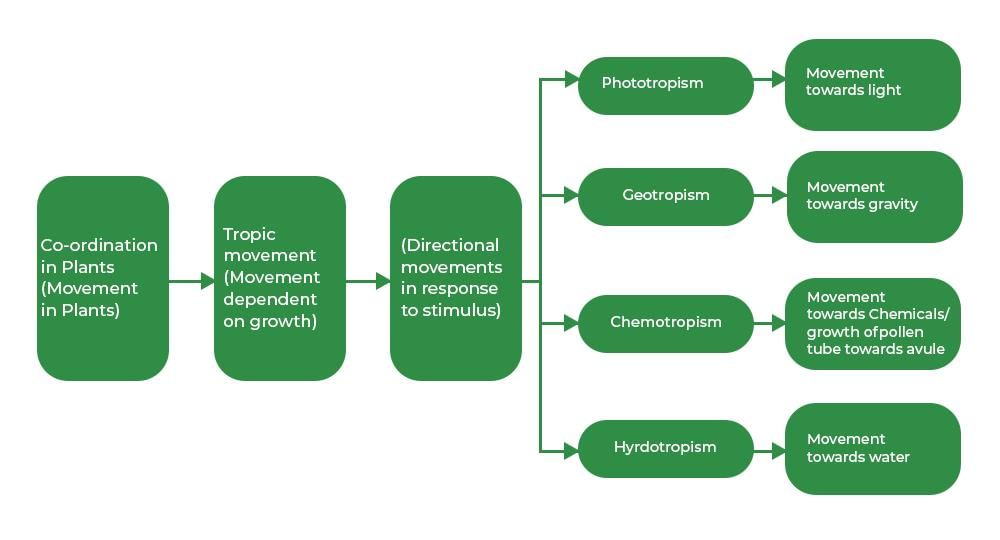Class 10 Exam > Class 10 Notes > Biology Class 10 ICSE > Revision Notes: Chemical Coordination in Plants
Revision Notes: Chemical Coordination in Plants | Biology Class 10 ICSE PDF Download
Introduction

Plant hormones, also known as phytohormones, play a crucial role in regulating various aspects of plant growth, including cell division, cell enlargement, and cell differentiation. These hormones are produced in specific parts of the plant and can significantly influence their development.
- Auxins
- Auxins are responsible for promoting the growth of plants.
- They are secreted by the cells present in the tips of stems and roots.
- Synthetic auxins are used in horticulture to encourage plant growth.
- Gibberellins
- Gibberellins promote cell differentiation, but this process occurs in the presence of auxins.
- They are also involved in breaking seed dormancy, stimulating the elongation of shoots.
- Cytokinins
- Cytokinins play a vital role in promoting cell division in plants.
- They also help delay the ageing of leaves, promote the opening of stomata, and stimulate fruit growth.
- Abscisic Acid
- Abscisic acid acts as a growth inhibitor and promotes dormancy in seeds and buds.
- It also encourages the closing of stomata, wilting and falling of leaves, and the detachment of flowers and fruits from plants.
Movement Due to Growth

Movement of plant organs towards or away from a stimulus is known as tropism.
Since the tropic movements are slow, the stimulus needs to be continued for a longer time for the effects to be noticed.
Different types of tropic movements in plants:
- Phototropism
- Movement of plant parts towards or away from light is termed phototropism.
- Because shoots of most plants grow towards the source of light, it is termed positive phototropism.
- Roots grow away from light and hence are negatively phototropic.
- Geotropism
- Movement of plant organs in response to gravity is termed geotropism.
- Roots are positively geotropic because they grow in the direction of gravity.
- The shoot grows upwards, i.e. against gravity, and hence is negatively geotropic.
- Thigmotropism
- Movement of plant organs in response to stimuli caused by physical contact with solid objects is termed thigmotropism.
- Weak-stemmed plants use twining stems and tendrils to climb on other plants/objects which provide them support. Hence, twining stems and tendrils are positively thigmotropic.
- Hydrotropism
- Movement of plant organs in response to water is termed hydrotropism.
- Roots grow towards the source of moisture and hence are positively hydrotropic.
- Chemotropism
- Movement of plant organs in response to a chemical stimulus is called chemotropism.
- When plant organs grow away from the chemical response, it is called negative chemotropism.
- When plant parts grow towards the chemical response, it is called positive chemotropism. For example, pollen tubes grow towards the sugary substance secreted by the stigma of the flower.
- Heliotropism
- Diurnal motion or seasonal motion of plant parts in response to the direction of the Sun is termed heliotropism.
- Sunflowers contain auxins which are sensitive to sunlight.
- They stimulate the growth of the cells in the shaded region of the stem so that the flowers end up bending in the opposite direction, i.e. towards the Sun.
The document Revision Notes: Chemical Coordination in Plants | Biology Class 10 ICSE is a part of the Class 10 Course Biology Class 10 ICSE.
All you need of Class 10 at this link: Class 10
|
55 videos|189 docs|21 tests
|
FAQs on Revision Notes: Chemical Coordination in Plants - Biology Class 10 ICSE
| 1. What are plant hormones and their significance in chemical coordination? |  |
Ans.Plant hormones, also known as phytohormones, are chemical substances produced by plants that regulate various physiological processes. They play crucial roles in growth, development, flowering, fruiting, and responses to environmental stimuli. The main types of plant hormones include auxins, gibberellins, cytokinins, abscisic acid, and ethylene, each serving specific functions in chemical coordination within the plant.
| 2. How do auxins function in plant growth and development? |  |
Ans.Auxins are a class of plant hormones that promote cell elongation, root formation, and fruit development. They are primarily produced in the apical meristem (the growing tip of the plant) and influence phototropism (growth towards light) and gravitropism (growth in response to gravity). By redistributing auxins in response to environmental changes, plants can adapt their growth patterns accordingly.
| 3. What role do cytokinins play in plant physiology? |  |
Ans.Cytokinins are hormones that promote cell division and are primarily found in areas of active growth, such as roots and developing fruits. They work in conjunction with auxins to regulate various processes, including shoot development, leaf expansion, and delaying aging in leaves. Cytokinins are also involved in nutrient mobilization and can influence the development of lateral buds.
| 4. What is the function of abscisic acid in plants? |  |
Ans.Abscisic acid (ABA) is a plant hormone that primarily functions to manage stress responses. It plays a crucial role in regulating stomatal closure during drought conditions, thereby reducing water loss. ABA also influences seed dormancy and helps in the maturation of seeds. By coordinating these stress responses, ABA helps plants survive adverse environmental conditions.
| 5. How does ethylene affect fruit ripening and plant responses? |  |
Ans.Ethylene is a gaseous plant hormone that plays a significant role in the process of fruit ripening. It promotes ripening by stimulating the conversion of starches to sugars, softening of fruit tissue, and the development of characteristic flavors and aromas. Ethylene also influences other plant responses, such as leaf senescence and flower wilting, by triggering various biochemical pathways.
Related Searches





















